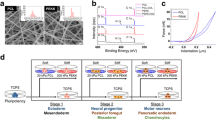Abstract
Embryonic stem cells (ESCs) are useful resources for drug discovery, developmental biology and disease studies. Cellular microenvironmental cues play critical roles in regulating ESC functions, but it is challenging to control them with synthetic components. Nanofibers hold a potential to create artificial cellular cues for controlling cell adhesion and cell–cell interactions. Mouse ESC (mESC) were cultured on electrospun nanofibers made from polymethylglutarimide (PMGI), which is a synthetic thermoplastic polymer stable under culture conditions. Both topology and the density of PMGI nanofibers were key factors. mESCs on nanofibers had a growth rate comparable to those cultured conventionally and retained their pluripotency. Furthermore, self-renewed ESCs differentiated into all three germ layers thereby providing a reliable way to expand mESCs without feeder cells.



Similar content being viewed by others
References
Connelly JT, Gautrot JE, Trappmann B, Tan DW, Donati G, Huck WT, Watt FM (2010) Actin and serum response factor transduce physical cues from the microenvironment to regulate epidermal stem cell fate decisions. Nat Cell Biol 12(7):711–718
Gauthaman K, Venugopal JR, Yee FC, Peh GS, Ramakrishna S, Bongso A (2009) Nanofibrous substrates support colony formation and maintain stemness of human embryonic stem cells. J Cell Mol. Med 13(9B):3475–3484
Liu L, Shi J, Yuan QH, Wang L, Chen Y (2010) Growth and attachment of embryonic stem cell colonies on single nanofibers. Micro Nanosyst 2:269–273
Neal RA, McClugage SG, Link MC, Sefcik LS, Ogle RC, Botchwey EA (2009) Laminin nanofiber meshes that mimic morphological properties and bioactivity of basement membranes. Tissue Eng. Part C Methods 15(1):11–21
Nur-E-Kamal A, Ahmed I, Kamal J, Schindler M, Meiners S (2006) Three-dimensional nanofibrillar surfaces promote self-renewal in mouse embryonic stem cells. Stem Cells 24(2):426–433
Shi J, Wang L, Zhang F, Li H, Lei L, Liu L, Chen Y (2010) Incorporating protein gradient into electrospun nanofibers as scaffolds for tissue engineering. ACS Appl Mater Interfaces 2(4):1025–1030
Wobus AM, Boheler KR (2005) Embryonic stem cells: prospects for developmental biology and cell therapy. Physiol Rev 85(2):635–678
Xia H, Nho RS, Kahm J, Kleidon J, Henke CA (2004) Focal adhesion kinase is upstream of phosphatidylinositol 3-kinase/akt in regulating fibroblast survival in response to contraction of type i collagen matrices via a β1 integrin viability signaling pathway. J Biol Chem 279(31):33024–33034
Xu C, Inokuma MS, Denham J, Golds K, Kundu P, Gold JD, Carpenter MK (2001) Feeder-free growth of undifferentiated human embryonic stem cells. Nat Biotechnol 19(10):971–974
Yeom YI, Fuhrmann G, Ovitt CE, Brehm A, Ohbo K, Gross M, Hübner K, Schöler HR (1996) Germline regulatory element of Oct-4 specific for the totipotent cycle of embryonal cells. Development 122(3):881–894
Acknowledgments
This work was supported by Grants-in-Aid for Scientific Research (B) and Young Scientists (B) of the Japan Society for Promotion of Science (JSPS, No. 22710116 and 22350104, respectively) and the European Commission through a project contract (CP-FP 214566-2, Nanoscales). We thank Dr. K. Hasegawa, Dr. C. Fockenberg and Ms. M. Nakajima for helpful discussions and supports.
Author information
Authors and Affiliations
Corresponding author
Electronic supplementary material
Below is the link to the electronic supplementary material.
Rights and permissions
About this article
Cite this article
Liu, L., Yuan, Q., Shi, J. et al. Chemically-defined scaffolds created with electrospun synthetic nanofibers to maintain mouse embryonic stem cell culture under feeder-free conditions. Biotechnol Lett 34, 1951–1957 (2012). https://doi.org/10.1007/s10529-012-0973-9
Received:
Accepted:
Published:
Issue Date:
DOI: https://doi.org/10.1007/s10529-012-0973-9




